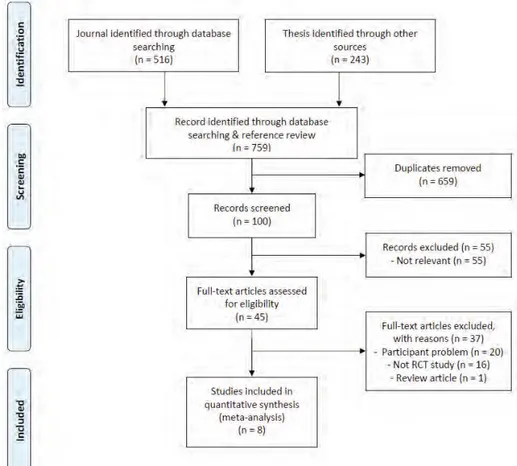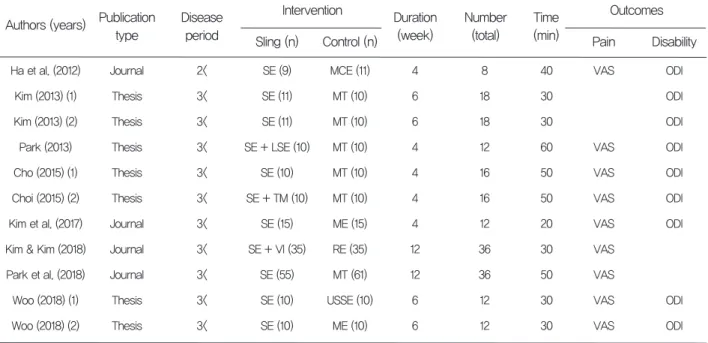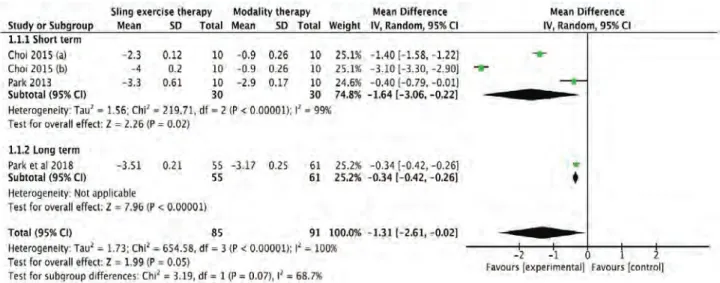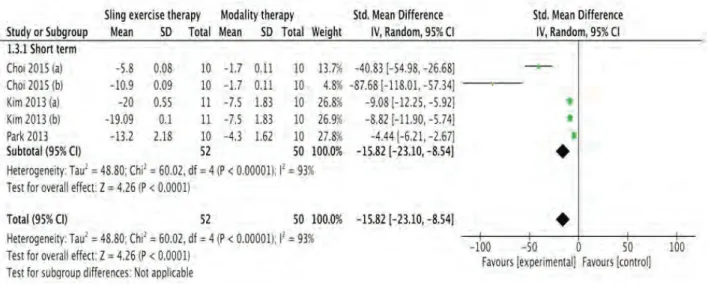About 85% of people experience low back pain (LBP) during their lifetimes.1,2LBP is a major cause of
dis-ability worldwide.3Acute LBP can be treated within 6
weeks.4 However, 71% of patients with acute LBP do
not fully recover.5 In this case, LBP over 12 weeks is
defined as chronic low back pain (CLBP).6,7 Prior
studies have shown that hospitalization and physical therapy incur large medical costs for managing LBP.8
CLBP is common in adults over 40 and leads to psy-chological problems such as low job satisfaction, anx-iety, depression, and negative perception.9
CLBP treatment is also needed for social and eco-nomic reasons. Many medical doctors rely on nons-teroidal anti-inflammatory drugs, opioids, and neu-rotropic medications, or steroid injections and surgery as their main tools.10However, in recent years,
non-pharmacological approaches have become popular.11
Various treatments have been proposed for the treat-ment of CLBP, but recent guidelines and reviews rec-ommend regular physical exercise.12,13Several previous
studies also reported that exercise can be compared to other conservative treatments to improve the pain intensity and disability of CLBP.14,15
Among the various exercise methods, sling exercise
Effects of Sling Exercise on Pain and Disability in Patients
with Chronic Low Back Pain: Meta-Analysis of Studies in
Korea
INTRODUCTION
Background: Various treatments have been proposed for chronic low back pain (CLBP), but recent guidelines and reviews recommend regular physical exercise. However, some other studies have reported opposite results that sling exercise (SE) and other exercises (OE) did not differ in improving CLBP. Objectives: To systematically review and meta-analyze the effects of SE on CLBP in studies published in Korea.
Design: A Systemic Review and Meta-analysis.
Methods: Randomized controlled trials comparing SE with OE and modality therapy (MT), published up to June 2020, were identified by electronic searches. Primary outcomes were pain and disability. The weighted mean dif-ference (WMD), stand mean difdif-ference (SMD) and 95% confidence interval (CI) were calculated using a random-effects model.
Results: Based on the results of the meta-analysis, SE was effective for pain in the comparison of SE and MT [shortterm: WMD=1.64, 95% CI (3.06, -0.22); long-term: WMD=-0.34, 95% CI (-0.42, -0.26)]. It was effective for pain in the comparison of SE and OE [shortterm: WMD=1.18, 95% CI (2.15, -0.20); long-term: WMD=-0.66, 95% CI (-0.89, -0.43)]. It was also effective for disability in the comparison of SE and MT [short-term: SMD=-15.82, 95% CI (-23.10, -8.54)]. We found no clinically relevant differences in disability between SE and OE. Heterogeneity was high in the comparison of SE and overall vari-ables.
Conclusion: If SE is applied to physical therapy to improve the main symptoms of CLBP patients, it may contribute to their recovery. More high-quality ran-domized studies on the topic are warranted.
Keywords: Chronic low back pain; Sling exercise; Pain; Disability; Meta-analysis
Chibok Park, PT, Prof., PhDa, Hojin Jeong, PT, Prof., PhDb, Byeonggeun Kim, PT, MSb
aDepartment of Physical Therapy, Chunnam
Techno University, Gokseong, Republic of Korea;
bDepartment of Physical Therapy, Nambu
University, Gwangju, Republic of Korea
Received : 10 June 2020 Revised : 17 July 2020 Accepted : 22 July 2020
Address for correspondence Byeonggeun Kim, PT, MS
Department of Physical Therapy, Nambu University, 23 Cheomdanjungang-ro, Gwangju, Republic of Korea
Tel: 82-10-4905-9286 E-mail: qudrms_92@naver.com
(SE) is widely used in hospitals and treatment rooms to manage high risks because the suspension mecha-nism attached to the ceiling provides an unstable device.16,17 SE has several features. Firstly, the SE is
weight-bearing training that adjusts muscle co-acti-vation to stabilize joints. Secondly, SE intensity can be controlled with elastic cords that can unload body weight.18 Thirdly, it is an efficient exercise for
nor-malizing muscle response pattern, adjusting postural balance, and reducing pain in patients with CLBP.19-21
Looking at previous studies on SE, it was reported that SE improved CLBP more than other exercise methods.22However, some other studies have
report-ed opposite results that SE and other exercise (OE) did not differ in improving CLBP.23 Therefore, the
effectiveness of SE compared with other treatments remains unclear.
As far as we know, Korea uses and studies SE more than any other country.24However, in the systematic
review and meta-analysis study, the Korea database is not included. So studies published in Korea has limitations that are not known worldwide. Therefore, the purpose of this study is to systematically review and meta-analyze the effects of SE on CLBP in studies published in Korea.
This study was conducted with the approval of the research by the Institutional Review Board of Nambu University (IRB: 1041478-2020-HR-029). This study was performed in accordance with PRISMA guidance, ensuring a rigorous approach.
The following databases were searched from the earliest available date to June 2020: Research Information Sharing Service, Korean Studies Information Service System, National Digital Science Library, DBpia, Earticle, scholar, and National Assembly Library. We used the search terms “Low Back Pain,” “Sling,” and “Sling Exercise” in Korean and English.
Types of studies
Only randomized controlled trials (RCT) investigat-ing the use of SE as a treatment for CLBP were included.
Types of participants
The study samples included patients with CLBP affected for longer than two months. University stu-dents, minors, and non-hospital gym customer studies were not included.
Types of interventions
We included articles in which SE was compared with modality treatment, as well as any OE treatment for CLBP.
Types of outcome measures
The findings were analyzed in two primary outcome categories: pain and disability. We categorized out-comes as short term (post-treatment assessment no longer than 6 weeks) or long term (≥12 weeks).
The two independent reviewers (First Author, Corresponding author) screened for potentially rele-vant titles and abstracts based on the pre-specified criteria (PICOS), and full-text articles were retrieved whenever necessary. If a journal article and thesis paper were duplicated, the journal article was adopt-ed. Disagreements were resolved by the principle of majority voting, including the views of co-authors.
The two independent reviewers (First Author, Corresponding author) abstracted and cross-checked the data obtained from the included trials. These data were then compiled in a pre-designed data extraction form. Disagreements were resolved by the principle of majority voting, including the views of co-authors.
The two independent reviewers (First Author, Corresponding author) used the Cochrane Collaboration’s risk of bias tool to evaluate the methodological quality of all included studies. The following domains were evaluated: random sequence generation, allocation concealment, blinding of par-ticipants and personnel, blinding of outcome assess-ments, incomplete outcome data, selective reporting, and other bias. For each domain, each study’s description of methods was examined and a judgment regarding potential bias was made according to three categories: low risk, high risk and unclear risk. Disagreements were resolved by the principle of majority voting, including the views of co-authors.
METHODS
Literature Search Selection of Studies Data Extraction Inclusion Criteria Quality AssessmentMeta-analysis procedure was performed with Revman 5.4. The random effects model was used to estimate the mean of the distributions of the effect sizes of different populations. WMD was used when individual studies were in the same unit. SMD was used when individual studies were different units. A chi-square test was performed to detect statistically significant heterogeneity. We then estimated the amount of heterogeneity among studies by using the I2statistic: <25%, low; <50%, moderate heterogeneity;
and >50%, substantial heterogeneity. Heterogeneity was further investigated by checking data extracted from outlier studies and exploring the effects of study exclusion in sensitivity analyses. No funnel plots or assessments for publication bias were performed because of the small number of studies (maximum three studies) that were pooled in the comparisons included in this literature. The control conditions were divided into two groups: Modality therapy and other exercise. We then performed separate subgroup analyses for short-term and long-term follow-up time points. One study included two different control
groups, which were individually considered during analysis.
We initially retrieved 759 articles (Journal: 516, Thesis: 243) from the databases that were relevant to the search terms. Eight studies were finally included for analysis (Figure 1).
We included eight single-center randomized con-trolled studies with the aim to examine the efficacy of SE on CLBP.25-32These were four journal articles and
four theses. They were published between 2012 and 2018. One study was published in English, and the rest were published in Korean. The summarized characteristics of the studies included in our system-atic review are presented in Table 1.
Statistical Analysis
Literature Search
Study characteristics
Figure 1. Flowchart of the study selection process
The eight studies were randomized, but no details were provided.25-32We could not determine the
alloca-tion concealment of the eight studies.25-32None of the
studies met the criterion of blinding of participants and outcome assessors.25-32 Given the direct
partici-pant involvement due to the nature of therapeutic trials, and self-reported outcome measures such as
pain and disability, it was not feasible to blind partic-ipants and outcome assessors.25-32The risk of
incom-plete outcome data was low for only six included studies.25,27-30,32 Selective outcome reporting was at a
low risk of bias in all eight included studies25-32, while
sources of other bias were unclear.25-32Figure 2 shows
the detailed results of the quality assessment of indi-vidual characteristics.
SE: sling exercise, MCE: motor control exercise, VAS: visual analogue scale, ODI: oswestry disability index, MT: modality therapy, LSE: lumbar stabilization exercise, TM: thoracic mobilization, ME: mat exercise, VI: vibration, RE: resistance exercise, USSE: unstable supporting surface exercise
Authors (years) Publication type Disease period Journal Thesis Thesis Thesis Thesis Thesis Journal Journal Journal Thesis Thesis 2< 3< 3< 3< 3< 3< 3< 3< 3< 3< 3< Ha et al. (2012) Kim (2013) (1) Kim (2013) (2) Park (2013) Cho (2015) (1) Choi (2015) (2) Kim et al. (2017) Kim & Kim (2018) Park et al. (2018) Woo (2018) (1) Woo (2018) (2) SE (9) SE (11) SE (11) SE + LSE (10) SE (10) SE + TM (10) SE (15) SE + VI (35) SE (55) SE (10) SE (10) Intervention Sling (n) Control (n) MCE (11) MT (10) MT (10) MT (10) MT (10) MT (10) ME (15) RE (35) MT (61) USSE (10) ME (10) Duration (week) Time (min) 4 6 6 4 4 4 4 12 12 6 6 Number (total) 8 18 18 12 16 16 12 36 36 12 12 40 30 30 60 50 50 20 30 50 30 30 VAS VAS VAS VAS VAS VAS VAS VAS VAS Outcomes Pain Disability ODI ODI ODI ODI ODI ODI ODI ODI ODI Table 1. Characteristics of studies included in the analysis
Methodological Quality of Included Studies
The studies comparing SE with MT revealed significant shortterm [WMD=1.64, 95% CI (3.06, -0.22), P<0.00001] and long-term [WMD=-0.34, 95% CI (-0.42, -0.26)] differences in pain (Figure 3). The heterogeneity for short-term pain was substantially high (I2= 99%). A meta-analysis excluding Choi 2015
(b) reduced heterogeneity (I2= 95%) and revealed a
statistically significant effect size [WMD=-0.92, 95% CI (-1.90, 0.06), P<0.00001].
The studies comparing SE with OE revealed significant shortterm [WMD=1.18, 95% CI (2.15, -0.20), P<0.00001] and long-term [WMD=-0.66, 95% CI (-0.89, -0.43)] differences in pain (Figure 4). The heterogeneity for short-term pain was substantially high (I2 = 97%). A meta-analysis excluding Woo 2018
(a) and (b) reduced heterogeneity (I2= 0%) and revealed
a statistically non-significant effect size [WMD=-0.38, 95% CI (-0.63, -0.12), P=0.33].
Comparison of SE and MT for pain Comparison of SE and OE for pain
The studies comparing SE with MT revealed significant shortterm [SMD=15.82, 95% CI (23.10, -8.54), P<0.00001] differences in disability (Figure 5). The heterogeneity for short-term disability was sub-stantially high (I2= 93%). A meta-analysis excluding
Choi 2015 (a) and (b) reduced heterogeneity (I2=80%)
and revealed a statistically significant effect size [SMD=-7.24, 95% CI (-10.61, -3.87), P=0.008].
The studies comparing SE with OE revealed non-significant short-term [WMD=-2.96, 95% CI (-3.71, -2.20), P=0.06] differences in disability (Figure 6). The heterogeneity for short-term disability was sub-stantially high (I2= 60%). A meta-analysis excluding
Woo 2018 (a) and (b) reduced heterogeneity (I2=0%)
and revealed a statistically non-significant effect size [WMD=-2.18, 95% CI (-3.01, -1.35), P=0.84]. Comparison of SE and MT for disability Comparison of SE and OE for disability
Figure 5. Forest plots for effect size comparison of SE and MT for disability
In this study, the effect of SE was compared to MT and OE and analyzed based on prior studies of CLBP patients published in Korea from the earliest search-able date to June 2020.
Comparing and analyzing SE and MT or OE for pain, the overall average effect size for SE was high effect size (MT: -1.31, OE: -1.07). This is consistent with the result that pain is less with SE than MT and OE when SE is applied to CLBP patients.33 SE
pro-vides an unstable support surface, it is thought to reduce pain by inducing co-contraction of muscles and providing lumbar-pelvic stability.34Therefore, SE
is thought to be more effective in reducing pain than MT and OE.
Comparing and analyzing SE and MT for disability, the overall average effect size for SE was high effect size (MT: -15.82). This is the result of recovering from dysfunction more with SE than MT when SE is applied to CLBP patients. It is thought that it had a positive effect on disability recovery by promoting neuromuscular activation during SE and smoothing the coordination ability of trunk muscles.35
In this study, no difference was found as a result of comparing the effect size of SE and OE on disability. This is consistent with the study results that exercise therapy is more effective in recovering from dysfunc-tion than MT.14,15 This is consistent with the result
that there is no difference from OE when SE is applied to CLBP patients.33 ODI evaluation items
included the degree of pain. It has been reported that exercise therapy as well as SE improved pain, so it seems to have affected the ODI evaluation as the pain decreased.
As a result of analyzing a study published in Korea, SE was effective in improving pain and disability. The results of this study could be used as evidence for the use of se in the treatment of CLBP patients in hospi-tals in Korea.
An additional search was conducted on August 30 at the final stage of the study. Six studies were found at the last re-search of the study. However, the studies did not meet the criteria of this study.
There are some limitations in this study. The num-ber of RCT studies was small. The small numnum-ber of studies has several influences. It is difficult to gener-alize the effects of SE, and overall heterogeneity is high in this study. In order to perform an additional meta-regression analysis for the reason of high het-erogeneity, at least 10 studies were required, so fur-ther analysis was limited. Because of the small num-ber of studies, it was not evaluated for publication
bias. Hand searching was not conducted in this study. Therefore, a wider range of research analysis and verification is required for SE by supplementing the limitations in this study, and further qualitative follow-up studies should be conducted continuously.
The results of this study showed that SE for CLBP patients had a positive effect on pain and disability. SE may contribute to the recovery of CLBP patients if it is applied in physical therapy to improve the main symptoms of CLBP patients. In addition, high-quali-ty clinical research on SE should continue.
No potential conflict of interest relevant to this arti-cle was reported
DISCUSSION
CONCLUSION
CONFLICT OF INTERESTS
REFERENCES
1. 2. 3. 4. 5. 6.Hoy D, Bain C, Williams G, et al. A systematic review of the global prevalence of low back pain. Arthritis Rheum. 2012;64(6):2028-2037.
Andersson GB. Epidemiological features of chronic low-back pain. The lancet. 1999;354 (9178):581-585.
Vos T, Abajobir AA, Abate KH, et al. Global, regional, and national incidence, prevalence, and years lived with disability for 328 diseases and injuries for 195 countries, 1990–2016: a systematic analysis for the Global Burden of Disease Study 2016. The Lancet. 2017;390(10100):1211-1259. Costa LdCM, Maher CG, Hancock MJ, McAuley JH, Herbert RD, Costa LO. The prognosis of acute and persistent low-back pain: a meta-analysis. Cmaj. 2012;184(11):E613-E624.
Itz CJ, Geurts J, Van Kleef M, Nelemans P. Clinical course of non-specific low back pain: A systematic review of prospective cohort studies set in primary care. Eur J Pain. 2013;17(1):5-15. Qaseem A, Wilt TJ, McLean RM, Forciea MA. Noninvasive treatments for acute, subacute, and chronic low back pain: a clinical practice guideline from the American College of Physicians. Ann Intern Med. 2017;166(7):514-530.
7. 8. 9. 10. 11. 12. 13. 14. 15. 16. 17. 18.
Koes BW, Van Tulder M, Lin CW, Macedo LG, McAuley J, Maher C. An updated overview of clinical guidelines for the management of non-specific low back pain in primary care. Eur Spine J. 2010;19(12):2075-2094.
Dagenais S, Caro J, Haldeman S. A systematic review of low back pain cost of illness studies in the United States and internationally. Spine J. 2008;8(1):8-20.
van Tulder M, Koes B, Bombardier C. Low back pain. Best Pract Res Clin Rheumatol. 2002;16 (5):761-775.
Salzberg LD, Manusov EG. Management options for patients with chronic back pain without an etiology. Health Serv Insights.2013;6:HSI. S10469.
Deyo RA, Mirza SK, Turner JA, Martin BI. Overtreating chronic back pain: time to back off? J Am Board Fam Med.2009;22(1):62-68.
O'Connell NE, Cook CE, Wand BM, Ward SP. Clinical guidelines for low back pain: a critical review of consensus and inconsistencies across three major guidelines. Best Pract Res Clin Rheumatol. 2016;30(6):968-980.
Bell JA, Burnett A. Exercise for the primary, sec-ondary and tertiary prevention of low back pain in the workplace: a systematic review. J Occup Rehabil. 2009;19(1):8-24.
Hayden JA, Van Tulder MW, Tomlinson G. Systematic review: strategies for using exercise therapy to improve outcomes in chronic low back pain. Ann Intern Med. 2005;142 (9):776-785. van Middelkoop M, Rubinstein SM, Kuijpers T, et al. A systematic review on the effectiveness of physical and rehabilitation interventions for chronic non-specific low back pain. Eur Spine J. 2011;20(1):19-39.
Kang H, Jung J, Yu J. Comparison of trunk muscle activity during bridging exercises using a sling in patients with low back pain. J Sports Sci Med. 2012;11(3):510.
Lee JS, Yang SH, Koog YH, Jun HJ, Kim SH, Kim KJ. Effectiveness of sling exercise for chronic low back pain: a systematic review. J Phys Ther Sci. 2014;26(8): 1301-1306.
Yun K, Lee S, Park J. Effects of closed chain exercises for the lumbar region performed with local vibration applied to an unstable support surface on the thickness and length of the trans-verse abdominis. J Phys Ther Sci. 2015;27(1) :101-103. 19. 20. 21. 22. 23. 24. 25. 26. 27. 28. 29.
Lee SW, Kim SY. Effects of hip exercises for chronic low-back pain patients with lumbar instability. J Phys Ther Sci. 2015;27(2):345-348. Park H, Jeong T, Lee J. Effects of sling exercise on flexibility, balance ability, body form, and pain in patients with chronic low back pain. Rehabil Nurs. 2017;42(6):E1-E8.
Kim JH, Kim YE, Bae SH, Kim KY. The effect of the neurac sling exercise on postural balance adjustment and muscular response patterns in chronic low back pain patients. J Phys Ther Sci. 2013;25(8):1015-1019.
Yoo YD, Lee YS. The effect of core stabilization exercises using a sling on pain and muscle strength of patientswith chronic low back pain. J Phys Ther Sci. 2012; 24(8):671-674.
Unsgaard-Tøndel M, Fladmark AM, Salvesen Ø, Vasseljen O. Motor control exercises, sling exercises, and general exercises for patients with chronic low back pain: a randomized controlled trial with 1-year follow-up. Phys Ther. 2010;90(10):1426-1440.
Find a Neurac Practitioner. Redcord. https://red-cord. com/treatment/certified-neurac-practi-tioner/. Accessed August 29, 2020.
Ha YS, Lee JS, Kim SS, Lee BH. The Effect of Sling Exercise Therapy and Motor Control Exercise on Pain, ADL Performance and Trunk Muscle Strength in Patients with Chronic Low Back Pain. Journal of Korean Medicine Rehabilitation. 2012;22(3):151-162.
Kim SH. The Effect of chronic low back pain patients to cross section area of multifidus muscle and functional activity to during Push-up plus Exercise using sling [Master's thesis]. Naju, Republic of Korea: Dongshin University; 2013. Park JI. The Effects of Lumbar Disability and Pain on Combinated Neurac Sling and Lumbar stabilization Exercise [Master's thesis]. Gwangju, Republic of Korea: Nambu University; 2013. Choi JS. The Effect of thoracic spine Mobilization passing through the sling on the static and dynamic balance of chronic low back pain patients [Master's thesis]. Naju, Republic of Korea: Dongshin University; 2015.
Kim CD, Kim HK, Jeong UC, Kim CY. Effects of Specific Exercise Types on Pain, Disability Index and Static Balance in Patients with Chronic Lower Back Pain: A randomized, single-blind study. J Int Acad Phys Ther Res. 2017;8(3):1216-1223.
Search strategy : RISS, KISS, NDSL, DBpia, Earticle, scholar, and National Assembly Library
Koeran #1 요통 AND 슬링 #2 요통 AND 슬링운동 #3 허리통증 AND 슬링 #4 허리통증 AND 슬링운동 English
#5 low back pain AND sling
#6 low back pain AND sling exercise 30.
31.
32.
Kim DH, Kim TH. The Effects of Sling and Resistance Exercises on Muscle Activity and Pelvic Rotation Angle During Active Straight Leg Raises and Pain in Patients with Chronic Low Back Pain. Journal of the Korean Society of Physical Medicine. 2018;13(4):113-121.
Seung JP, Ji HM, Yun AS. Change of Pain, Lumbar Sagittal Alignment and Multifidus after Sling Exercise Therapy for Patients with Chronic Low Back Pain. Journal of Korean Society of Physical Therapy. 2018;30(5):173-181.
Woo HM. The Effects of Sling Exercise on Pain and Gluteus Maximus and Latissimus Dorsi
33.
34.
35.
Activity of Patients with Chronic Low Back Pain [Master's thesis]. Gyeongbuk, Republic of Korea: Daegu University; 2018.
Yue YS, Wang XD, Xie B, et al. Sling exercise for chronic low back pain: a systematic review and meta-analysis. PLoS One. 2014;9(6):e99307. Vleeming A, Pool-Goudzwaard AL, Stoeckart R, van Wingerden JP, Snijders CJ. The posterior layer of the thoracolumbar fascia. Spine. 1995;20:753-758.
Kirkesola G. Neurac-a new treatment method for chronic musculoskeletal pain. Fysiotherapeuten. 2009;76:16-25.



